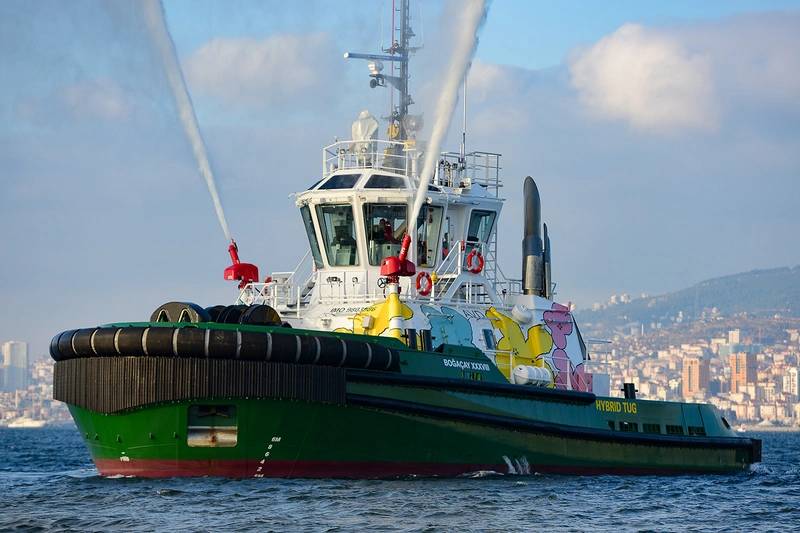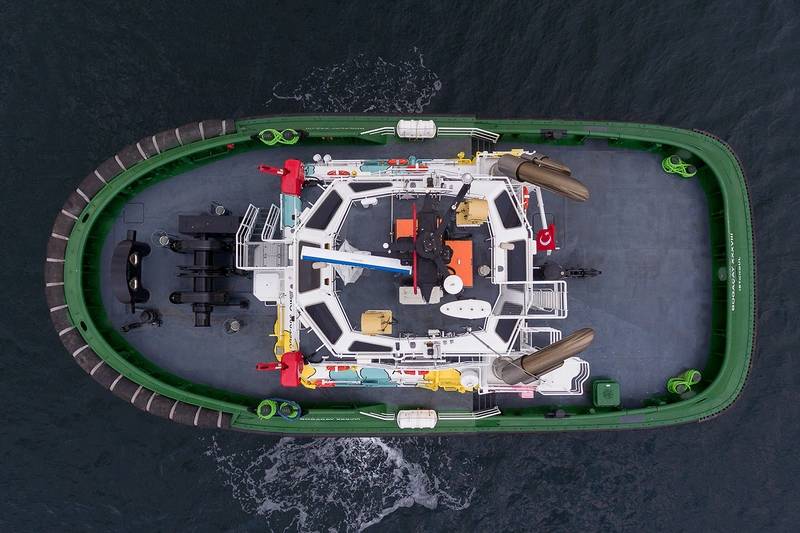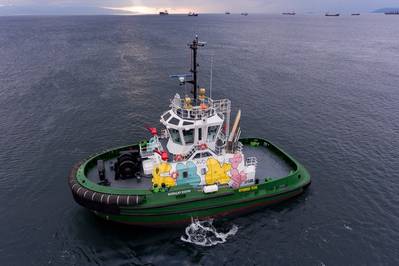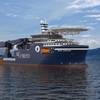Sanmar and Robert Allan: 200 Tugs and Counting
A ceremony at Sanmar's Altinova shipyard on January 11, 2020 celebrated the commissioning of the 200th tug built by Sanmar to a Robert Allan Ltd. design -- an achievememt reached in just over 25 years' time.
The milestone tug, the Boğaçay XXXVIII, is the latest evolution of the RAmparts 2400-SX design, incorporating the newly developed CAT Advanced Variable DriveTM (AVDTM) hydro-mechanical hybrid propulsion system. At the time of writing the tug is joining Sanmar's towage fleet in Izmit Bay, Turkey.
Boğaçay XXXVIII has been painted with a bright green hull and colorful flowers on the deckhouse inspired by the famous pop artist Andy Warhol's "Flowers" print. This regalia, reflective of the changing trend toward reduced environmental impact from tugs is bound to attract much attention in the usually moribund world of tugboat aesthetics.
 (Photo: Robert Allan Ltd.)
(Photo: Robert Allan Ltd.)
The particulars of this new tug are as follows:
- Length overall: 24.4 m
- Beam, molded: 11.25 m
- Depth, molded: 4.38 m
- Maximum draft: 5.4 m
The vessel is classed by ABS with the notation:
✠ A1, TOWING VESSEL, ✠ AMS, ✠ ABCU, UWILD, QR, UNRESTRICTED SERVICE, BP (70 tonnes)
Tank capacities are:
- Fuel oil: 72.4 m3
- Fresh water: 10.8 m3
- Fi-Fi foam: 6.6 m3
The CAT AVD TM system consists of a pair of dual input, continuously variable transmissions, located in the shaftlines between the main engines and the Z-drives. The AVDs can accept power from the CAT 3512 main engines, rated 1,765 kW at 1,800 rpm and/or from two 435 kW hydraulic motors powered by a single CAT C32 auxiliary engine rated 1,081 kW at 2,100 rpm. The power is delivered to two CAT MTA 627 FP Z-drive units with 2.7 meter diameter fixed pitch propellers.
A primary advantage of the CAT AVD TM system is the continuously variable transmission which can modulate propeller speed down to 0 rpm like a slipping clutch. It can also spin the propeller up faster than would be possible if the engine was directly coupled to the drive, allowing the engines to operate in their peak efficiency zone instead of operating along the propeller demand curve at higher specific fuel oil consumption, thus resulting in significant fuel savings. With a FP propeller pitched for bollard condition at 0 knots, this feature enables full power to be taken from the engine when free running, much like a CP or DEP system.
 (Photo: Robert Allan Ltd.)
(Photo: Robert Allan Ltd.)
Nathan Kelly, Caterpillar Marine Product Definition Engineer, said, "This (AVD system) allows propeller speed independent of engine speed so optimal engine efficiency can be achieved leading to fuel savings of 15% to 20%. Basically, all the benefits of a variable speed diesel electric propulsion (DEP) system at a fraction of the cost and size."
Other advantages include improved response and acceleration as well as lower overall maintenance costs due to significantly reduced operating hours on the main engines.
It is noteworthy that with this system the engines are smaller than would normally be the case in a tug of this power (3512 vs. 3516 engines). The additional power to achieve maximum bollard pull comes from the C32 engine that also drives the Fi-Fi pump. The machinery configuration and power flow scenarios for the four operating modes are illustrated below
The towing gear consists of:
- DMT Type TW-E 250KN electric double drum hawser winch with a pull of 250 kN at 0 – 9 meters/minute on low speed and 80 kN at 0 – 28 meters/minute on high speed
- Data Hidrolik tow hook
- Data Hidrolik 5 tonne aft capstan
The vessel has been outfitted for a crew of six people. The main deckhouse contains the galley, mess, two officer cabins, and a common WC. The lower deck contains two double berth cabins, a laundry, galley stores and a common WC space. The wheelhouse provides all round maximum visibility and exceptional visibility to the bow and side fendering. The engine room features a small, sound resistant switchboard room.
On trials, Boğaçay XXXVIII achieved 70.35 tonnes bollard pull and a free running speed of 13.3 knots.













